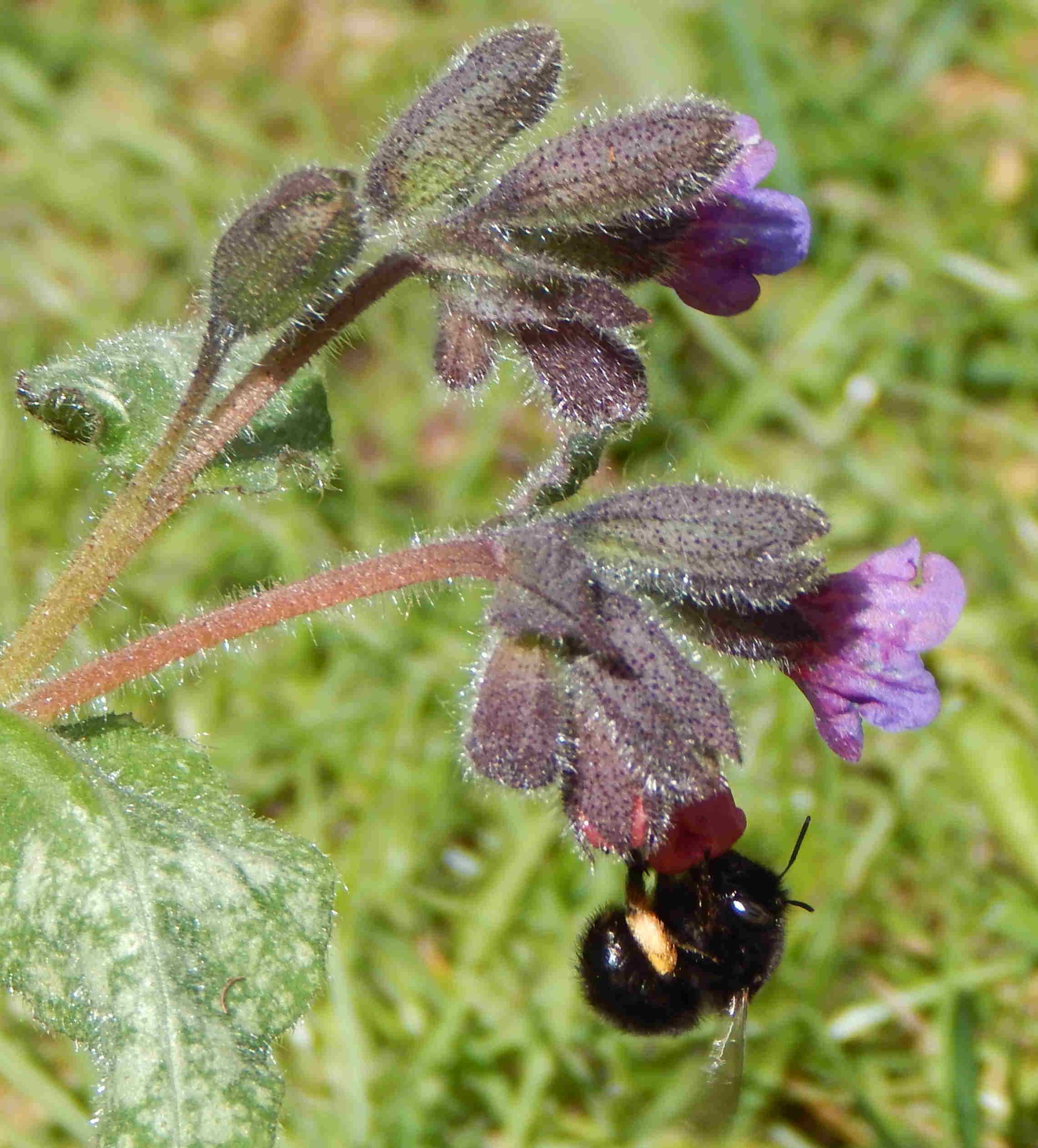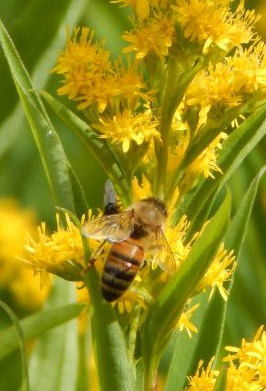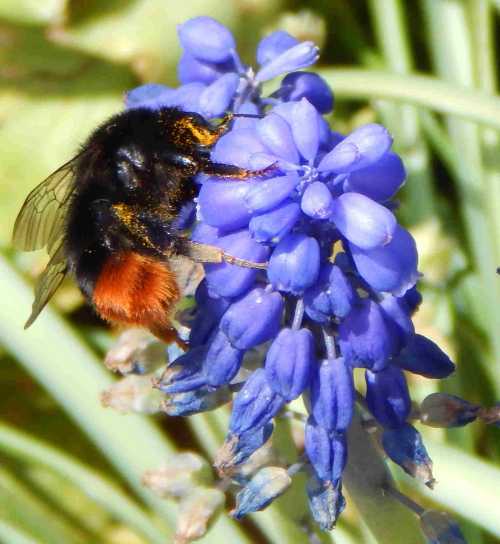Clay Soil Plants for Bees
Updated: 17th February 2021
Clay soil can be very challenging even without the conundrum of how to fill it with plants that will benefit bees and other pollinators.
In a garden I owned some years ago, I spent two years, a lot of energy, many hours and a
small fortune on conditioners and composts, trying to
break up the heavy, wet clay in order to improve it. However, the truth of the matter was that I had little time for gardening back then, and also very limited knowledge. At that time, it would have been far better had I simply stuck with plants that are happy in wet conditions. I could have saved myself quite a bit of money, and hours of work.
Of course, if you have the time, energy, money
and preferably all of these, there are actions you can take to resolve
the issue, even going as far as installing drainage systems. However, that could prove costly and unnecessary. There are plenty of clay soil tolerant plants that attract bees and other pollinators. You may be surprised at how many plants will tolerate it - indeed, I only mention a handful here. Also, please check the suitability of these plants in your own region and country.
If your soil is so bad you could almost consider supplying a pottery works, you may need to take action to improve it in order that anything will grow, but first of all, I would consider consulting a specialist organisation to see whether that's necessary.
Another option might be to create raised beds. I have no idea how this would work in the longer term with regard to drainage. A small scale experiment with this idea if it appeals to you, might be wise.
Planting For Bees In Clay Soil
In the meantime, why not try some of these clay soil - tolerant plants and shrubs in your garden. If you are able to grow them successfully, you are sure to attract bees and other pollinators once they are established. Also, see my tips below for seeking inspiration.
Flowering plants
- Pulmonaria 'Diana Clare'
 Anthophora plumipes - hairy-footed flower bee female on Pulmonaria.
Anthophora plumipes - hairy-footed flower bee female on Pulmonaria.- Campanula trachelium; Campanula latifolia
- Astrantia major 'Lars'
- Helenium 'Rubinzwerg'
- Veronicastrum virginicum 'Pointed Finger'
- Purple loosetrife - please note, this plant is considered invasive in some regions of the world, so do check first.
- Various hardy geranium flowers, including Geranium sylvaticum 'Birch Lilac'; Geranium palustre; Geranium × magnificum
 Leafcutter bee on geranium.
Leafcutter bee on geranium.- Solidago rugosa 'Fireworks'
 Apis mellifera - honey bee on Solidago.
Apis mellifera - honey bee on Solidago.- Rudbeckia fulgida var. sullivantii 'Goldsturm'
- Bergenia pacumbis
- Yellow flag iris
- Nepeta × faassenii 'Kit Cat'; Nepeta racemosa
- Dahlia 'Yellow Hammer' (Sin/dwb)
- Hosta
Shrubs and Trees for Clay Soil
Consider these options:
- Hypericum calycinum; Hypericum × hidcoteense 'Hidcote' (great for pollen)
 Bombus terrestris - buff-tailed bumble bee on hypericum.
Bombus terrestris - buff-tailed bumble bee on hypericum.- Malus (crab apple)
- Fuchsia: Fuchsia 'Globosa'; Fuchsia 'Other Fellow'; Fuchsia'Katrina Thompsen'
- Hebe × andersonii
- Viburnum tinus 'Variegatum' (v)
- Erica × darleyensis 'Epe'; Erica × darleyensis f. albiflora 'White Glow'; Erica × darleyensis 'Katia' (PBR) (Winter Belles Series); Erica cinerea 'Knap Hill Pink'
 Apis mellifera - honey bee on Erica.
Apis mellifera - honey bee on Erica.- Ribes nigrum 'Ben Sarek' (B); Ribes sanguineum 'Brocklebankii'
- Cornus amomum 'Blue Cloud'
- Hydrangea paniculata 'Kyushu'
- Salix caprea
- Pyracantha rogersiana; Pyracantha atalantioides
 Bombus terrestris - buff-tailed bumble bee on Hydrangea paniculata.
Bombus terrestris - buff-tailed bumble bee on Hydrangea paniculata.- Mahonia (excellent early source of food for bees). You could try: Mahonia × media 'Charity'; Mahonia × media 'Charity'; Mahonia × media 'Lionel Fortescue'; Mahonia × media 'Underway'; Mahonia oiwakensis subsp. lomariifolia
- Escallonia rubra
- Cotoneaster: Cotoneaster horizontalis, Cotoneaster lacteus: Cotoneaster conspicuous
- Buddleja davidii 'île de France'; Buddleja davidii 'Harlequin' (v);
- Berberis thunbergii f. atropurpurea 'Bagatelle'; Berberis thunbergii 'Green Carpet' ; Berberis thunbergii
Further inspiration - Tips
I have always found it useful to refer to nature for inspiration in dealing with difficult growing patches. I have a dry wooded area in my garden, and as a result I have looked to the flora of wooded areas for inspiration of what to grow.
For clay soil, I would seek to find plants that are happy to get their roots wet in the natural growing environment.
- Seek out natural habitats close to you that might resemble your growing conditions in some way.
- Look for pond bank flowers - yellow flag iris is a good example of a flower that happily grows in water, and in the flower border.
- Marshy coastal areas may also provide inspiration. I have found Solidago growing extremely well in such conditions.
Gardening
in these conditions is hard work - I know! However, before you spend a
great deal of money on resolving the issue, trying out a few of these
plants may be a good idea and could save a lot of money too!
If you found this page helpful or interesting, I'd really be grateful if you would share it with others - if not this page, perhaps another, such as Gardening For Bees.
Thank you so much :) .
